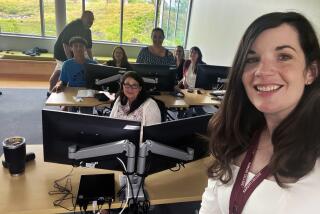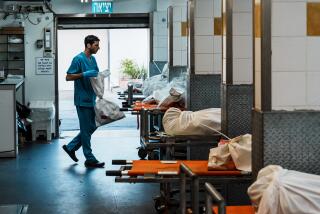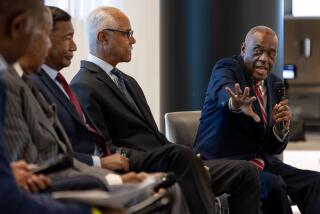Painstaking Puzzles Identify MIA Remains : Military: There have been 563 individual identifications and 40 to 50 cases are pending since the laboratory’s inception in 1973.
- Share via
HONOLULU — A few skeletal remains. Some teeth. A Sears credit card, dog tags, a pistol and boots.
This was once a U.S. airman, shot down over Vietnam. Now these are the only clues to who he was, and the Army’s Central Identification Laboratory must piece together the puzzle to verify his identity.
Acting as detectives, scientists and historians, the lab’s workers try to humanize the remains of U.S. military personnel listed as killed, missing in action or unaccounted for from World War II, the Korean War or the Vietnam War.
“I look at my family, my wife and children, and putting them in the same situation, if I had not returned, I would want somebody doing what I’m doing,” said Lt. Col. Johnie Webb Jr., a Vietnam veteran who served as the unit’s commander for 11 years and has been with the unit since its inception in 1973.
The goal, he said, is “to try and provide a family with answers to let them know what happened and, if possible, to bring them (the remains) back so they would have a grave they could visit.”
More than 2,200 servicemen are listed as unaccounted for from the Vietnam War, more than 8,000 from the Korean War and nearly 79,000 from World War II. There have been 563 individual identifications; 40 to 50 cases are pending.
The process of sorting out bone fragments and other possible clues is painstaking; despite recent advancements in computer and medical technology, cases can take years to resolve.
In the case of Army Sgt. Frank Morales, an infantryman killed in the Korean War in November, 1950, identification was made less than two months after the remains were repatriated by North Korea in December. Dental records were the key--Morales had bridge work, and many front teeth but few back teeth.
For the unknown airman, there was no easy medical identification.
Parts of the downed plane were repatriated with the remains last year, and this allowed officials to trace the four-man crew.
Checking the records, a forensic dentist matched an overhang in a filling of a tooth that was among the remains with an X-ray taken when the work was done on one of the four crewmen.
This wasn’t enough proof, so the lab had bone samples analyzed by scientists who extracted DNA and compared it with a DNA sample from a maternal relative of the airman.
A match was made and the case soon may be forwarded for the mandatory review process all cases must pass before identifications are approved.
The lab’s staff of 152 is based at Hickam Air Force Base and is divided into three units: search and recovery, casualty data analysis and laboratory.
Three search and recovery teams, which also include personnel from other military branches, conduct excavations and collect evidence from battle areas and crash sites. Once the remains are sent home, they are divided as best as possible into separate individuals.
The casualty data analysis section studies records and military historical data to verify information provided by the country that repatriated the remains, or tries to match information from battles and crashes with information recovered from excavations.
Using a computer database, workers scan records to see how many of the people listed as unaccounted for were in that particular area on a mission, or on a particular flight if remains were recovered from a crash site.
Working independently, anthropologists and experts in dentistry try to identify the remains, looking for clues to help determine age, size and other characteristics that may aid in identification.
Using the database, they narrow the possible choices to those who fit the description, then begin to check individual medical and dental records of people the computer says may fit the profile.
When the results of that work still leave a handful of possible matches, bone samples are taken when possible and sent to labs for possible DNA matching. Not all bones yield DNA because of deterioration and other factors.
Once a recommendation is made for positive identification, it’s sent for approval to the Armed Services Graves Registration Office, and the material is reviewed by an independent group of board-certified forensic consultants.
If the consultants agree with the recommendations, they are sent to the Armed Forces Identification Review Board for final approval.
A family can have the case reviewed at government expense by an independent expert of their choice, and can refuse to accept the remains.
“We try to put them at ease,” Webb said. “We often establish identity with a very small amount of remains of that individual, so it’s very difficult for the families to accept that this is their loved one.
“These families have lived with the uncertainty for a long time. We can relieve a lot of that uncertainty.”
More to Read
Sign up for Essential California
The most important California stories and recommendations in your inbox every morning.
You may occasionally receive promotional content from the Los Angeles Times.










